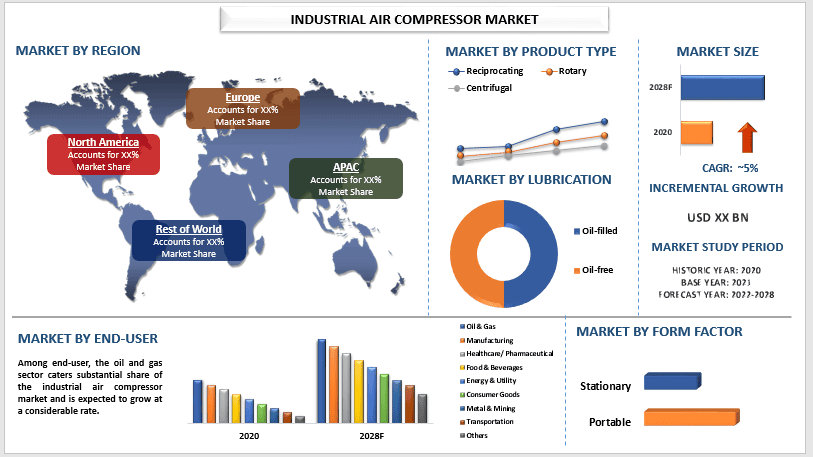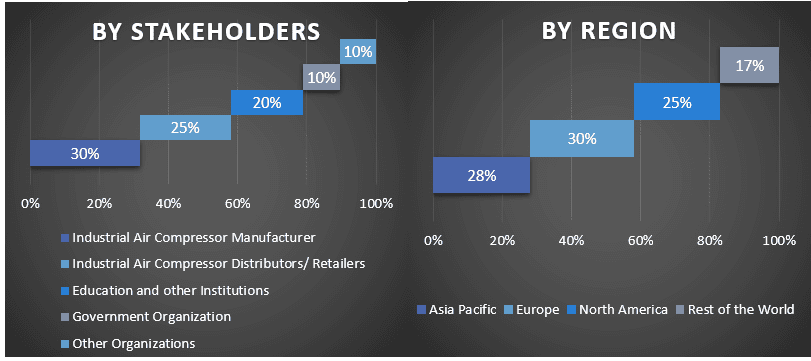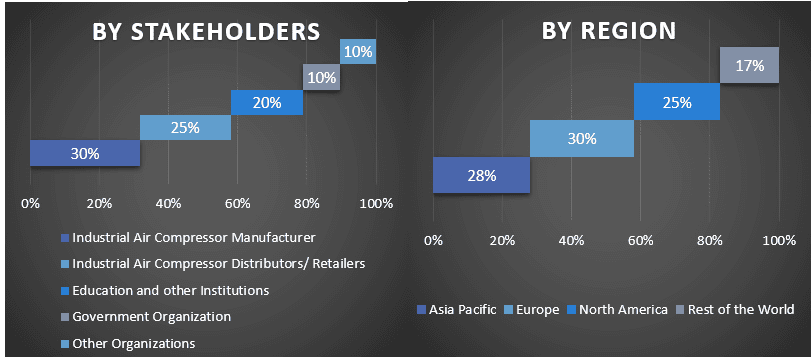Emphasis on Product Type (Reciprocating, Rotary, Centrifugal); Lubrication (Oil-filled, Oil-free); Form Factor (Portable, Stationary); End-User (Oil & Gas, Manufacturing, Healthcare/ Pharmaceutical, Food & Beverages, Energy & Utility, Consumer Goods, Metal & Mining, Transportation, Others); and Region/Country

The global Industrial Air Compressor Market is expected to grow at a significant rate of over 5% during the forecast period. Factors that are escalating the market share of industrial air compressors are increasing energy consumption, expansion of liquefaction facilities, and increasing demand for energy-efficient compressors all across the globe drives the demand for the market. Moreover, market demand for oil and oil-based products is growing despite significant advancements in alternate energy sources. As a result, industrial air and gas compressors have become indispensable for maintaining the proper pressure levels for these operations, with innovations focusing on lower energy requirements, increased speed, and greater ability to withstand harsh drilling environments to maintain a competitive edge.
Atlas Copco, Baker Hughes Company, GE, Hitachi Industrial Equipment Systems Co, MAN SE, MITSUBISHI HEAVY INDUSTRIES, LTD., Quincy Compressor, Siemens Energy AG, Kaeser Kompressoren, and Kaishan Compressor Co., Ltd.
Insights Presented in the Report
“Amongst product type, rotary compressor category to witness robust CAGR during the forecast period”
Based on product type, the industrial air compressors market is segmented into reciprocating, rotary, and centrifugal. The rotary compressor caters substantial share of the market. As they require minimum maintenance, offer better efficiency, and possess comparatively lower preliminary costs. In addition, technological advancements by manufacturers to provide satisfactory solutions to end users are enhancing the application of rotary compressors. They also have a long lifespan and low maintenance costs comparatively, which makes them preferable for end users.
“Amongst lubrication, oil-free segment to hold a significant share in the market in 2020”
Based on lubrication, the industrial air compressors market is classified into oil-filled, and oil-free. Among these, the oil-free segment to hold a significant share in the market in 2020. It is mainly due to the manufacturers in the industrial air compressor market are focusing on cost savings associated with oil-free compressors by eliminating the need for costly oil replacement. Since air purity is critical in several industries, demand for oil-free compressors is increasing as it eliminates the issues of oil spoilage or damage to the production equipment.
“Amongst end-user, oil & gas segment to hold a significant share in the market in 2020”
Based on end-user, the industrial air compressors market is classified into oil & gas, manufacturing, healthcare/ pharmaceutical, food & beverages, energy & utility, consumer goods, metal & mining, transportation, and others. Among these, the oil & gas segment to hold a significant share in the market in 2020. Increased demand for air compressors can be attributed to the need to preserve reservoir pressures through re-injection. In addition, growing investment in the oil and gas sector in various countries aimed at expansion of the oil industry will therefore support the growth of the market.
“Asia Pacific to hold a significant share in the market”
Asia Pacific is anticipated to grow at a substantial CAGR during the forecast period. This is mainly attributed to the increasing investment in infrastructure projects and rapid urbanization planning gaining pace in APAC coupled with growing demand for petrochemical/chemical products in India and China are escalating the adoption of industrial air compressors.
Reasons to buy this report:
Customization Options:
The global Industrial Air Compressor market can further be customized as per the requirement or any other market segment. Besides this, UMI understands that you may have your own business needs, hence feel free to connect with us to get a report that completely suits your requirements.
1. Market Introduction
2. Research Methodology Or Assumption
3. Market Synopsis
4. Executive Summary
5. Impact Of Covid-19 On The Industrial Air Compressor Market
6. Industrial Air Compressor Market Revenue, 2020-2028f
7. Market Insights By Product Type
8. Market Insights By Lubrication
9. Market Insights By Form Factor
10. Market Insights By End-user
11. Market Insights By Region
12. Industrial Air Compressor Market Dynamics
13. Industrial Air Compressor Market Opportunities
14. Industrial Air Compressor Market Trends
15. Demand And Supply-side Analysis
16. Value Chain Analysis
17. Competitive Scenario
18. Company Profiled
19. Disclaimer
Research Methodology for the Industrial Air Compressor Market Analysis (2022-2028)
Analyzing the historical market, estimating the current market, and forecasting the future market of the global Industrial Air Compressor market were the three major steps undertaken to create and analyze the adoption of Industrial Air Compressor in major regions globally. Exhaustive secondary research was conducted to collect the historical market numbers and estimate the current market size. Secondly, to validate these insights, numerous findings and assumptions were taken into consideration. Moreover, exhaustive primary interviews were also conducted, with industry experts across the value chain of the global Industrial Air Compressor market. Post assumption and validation of market numbers through primary interviews, we employed a top-down/bottom-up approach to forecasting the complete market size. Thereafter, market breakdown and data triangulation methods were adopted to estimate and analyze the market size of segments and sub-segments of the industry pertains to. Detailed methodology is explained below:
Analysis of Historical Market Size
Step 1: In-Depth Study of Secondary Sources:
Detail secondary study was conducted to obtain the historical market size of the Industrial Air Compressor market through company internal sources such as annual reports & financial statements, performance presentations, press releases, etc., and external sources including journals, news & articles, government publications, competitor publications, sector reports, third-party database, and other credible publications.
Step 2: Market Segmentation:
After obtaining the historical market size of the Industrial Air Compressor market, we conducted a detailed secondary analysis to gather historical market insights and share for different segments & sub-segments for major regions. Major segments are included in the report as product type, lubrication, form factor, and end-user. Further country-level analyses were conducted to evaluate the overall adoption of testing models in that region.
Step 3: Factor Analysis:
After acquiring the historical market size of different segments and sub-segments, we conducted a detailed factor analysis to estimate the current market size of the Industrial Air Compressor market. Further, we conducted factor analysis using dependent and independent variables such as various product type, lubrication, form factor, and end-user. A thorough analysis was conducted for demand and supply-side scenarios considering top partnerships, mergers and acquisitions, business expansion, and product launches in the Industrial Air Compressor market sector across the globe.
Current Market Size Estimate & Forecast
Current Market Sizing: Based on actionable insights from the above 3 steps, we arrived at the current market size, key players in the global Industrial Air Compressor market, and market shares of the segments. All the required percentage shares split, and market breakdowns were determined using the above-mentioned secondary approach and were verified through primary interviews.
Estimation & Forecasting: For market estimation and forecast, weights were assigned to different factors including drivers & trends, restraints, and opportunities available for the stakeholders. After analyzing these factors, relevant forecasting techniques i.e., the top-down/bottom-up approach were applied to arrive at the market forecast for 2028 for different segments and sub-segments across the major markets globally. The research methodology adopted to estimate the market size encompasses:
Market Size and Share Validation
Primary Research: In-depth interviews were conducted with the Key Opinion Leaders (KOLs) including Top Level Executives (CXO/VPs, Sales Head, Marketing Head, Operational Head, Regional Head, Country Head, etc.) across major regions. Primary research findings were then summarized, and statistical analysis was performed to prove the stated hypothesis. Inputs from primary research were consolidated with secondary findings, hence turning information into actionable insights.
Split of Primary Participants in Different Regions

Market Engineering
The data triangulation technique was employed to complete the overall market estimation and to arrive at precise statistical numbers for each segment and sub-segment of the global Industrial Air Compressor market. Data was split into several segments & sub-segments post studying various parameters and trends in the areas of product type, lubrication, form factor, and end-user in the global Industrial Air Compressor market.
The main objective of the Global Industrial Air Compressor Market Study
The current & future market trends of the global Industrial Air Compressor market were pinpointed in the study. Investors can gain strategic insights to base their discretion for investments on the qualitative and quantitative analysis performed in the study. Current and future market trends determined the overall attractiveness of the market at a regional level, providing a platform for the industrial participant to exploit the untapped market to benefit from a first-mover advantage. Other quantitative goals of the studies include:

Customers who bought this item also bought